Nicosia is a city of contrasts and quiet revelations. During my visit, I spent time crossing the Green Line and exploring Northern Cyprus, but I kept returning to the Greek Cypriot side, drawn by its distinct rhythm.
The streets here tell stories — some joyful, others solemn. There’s a mix of old-world charm and modern vitality, but what struck me most were the small, personal moments: locals chatting over backgammon, signs calling for peace, and hidden corners filled with history.

If you're curious about what makes Nicosia worth visiting, it’s not flashy landmarks or postcard-perfect scenes — it’s the layered authenticity of a city that’s been through so much and still pulses with life.
In this article, I’ll guide you through the highlights of Nicosia, what makes it worth visiting, and provide tips for discovering its hidden stories
But first, let's address your question: Is Nicosia worth visiting?
Disclosure: This article contains affiliate links. If you make a purchase through these links, I may earn a small commission at no extra cost to you. Thank you for supporting my blog!
Is Nicosia Worth Visiting?
Absolutely, yes — and let me tell you why!
When I first arrived in Nicosia, I wasn’t entirely sure what to expect. It’s not the flashy beaches of Ayia Napa or the ancient ruins of Paphos, but what I found was something entirely different: a city shaped by its complex past, traditions, and striking duality.
As the last divided capital in Europe, Nicosia offers an experience that’s as thought-provoking as it is unique.

Walking through the Old City, I discovered a mix of ancient walls, bustling streets filled with locals sipping coffee, and a blend of influences that tell the story of Cyprus’s complex past. Crossing the Green Line into Northern Nicosia added another dimension to the experience, as I stepped into a world that felt familiar yet distinctly different.
For me, Nicosia was less about ticking off famous landmarks and more about soaking it in.
If you’re drawn to history, cultural richness, and a slower, more reflective travel experience, then Nicosia is absolutely worth adding to your Cyprus itinerary.
But be warned — if you need constant entertainment or a long checklist of sights to feel satisfied (even if there are some sights here, outlined below), Nicosia might not be your kind of place. It’s not about ticking off attractions; it’s about experiencing something real.
Save this article for future reference!
Nicosia: The Last Divided City in Europe
Nicosia is a city unlike any other in Europe, not because of its architecture or nightlife, but because of its division — a line that separates not just geography but identity, politics, and culture.
Before arriving in Cyprus, I had little understanding of the Green Line and what it meant for the people living on either side. Exploring this city was as much a history lesson as it was a personal discovery.
The Green Line and Divided City
The Green Line, or UN Buffer Zone, cuts through the heart of Nicosia, separating the southern Greek Cypriot-controlled Republic of Cyprus from the northern Turkish-occupied territory. This division has been in place since 1974, following a military conflict that led to the island's partition. What was once a bustling, unified city centre became a no-man’s land, eerily frozen in time.
Crossing the Green Line today is simple, but the symbolism runs deep. A stroll along Ledra Street — the main pedestrian thoroughfare — takes you to a checkpoint where your passport is checked and processed before entering Northern Nicosia.


The transformation is immediate: signs shift from Greek to Turkish, Euros give way to Turkish Lira, and even the atmosphere seems to subtly change.
But it’s more than a political border. It’s a mirror reflecting decades of unresolved tension and loss, but also resilience. The Green Line has become both a scar and a thread, weaving the stories of people whose lives it continues to affect.
The Human Impact
For locals, the division isn’t just a relic of history; it shapes daily life. Some families were displaced and still hold keys to homes they haven’t seen in decades. Others have built lives that adapt to the divide, navigating the realities of two governments, two economies, and two identities in one city.
Despite the lingering tensions, there’s a palpable effort toward reconciliation. Projects that promote dialogue between the two communities are steadily growing. Walking through both sides of Nicosia, you sense not just division, but also hope — a quiet determination to bridge the gap, even if slowly.

If, like me, you arrive in Nicosia without much knowledge of its divided past, you’ll leave with a greater understanding of the complexities of human conflict and coexistence. The city doesn’t shy away from its wounds but wears them openly, asking you to reflect on what division — and unity — truly mean.
Nicosia is a story still being written, and visiting it gives you the chance to see it unfold.
Highlights of Nicosia (Greek Cypriot-Controlled)
One of the reasons why Nicosia is worth visiting is the Greek Cypriot-controlled side of the city. It's here that I started my time, navigating a mix of historic sites and local spots that shaped my understanding of Nicosia.
Over the course of two days, I explored a variety of landmarks. The following highlights represent the sites I visited, arranged in a way that roughly mirrors my route — a logical progression from west to east, with a figure-eight-like pattern that zigzags through Nicosia's historic core and its surrounding areas.
This allowed me to take in the city's most notable attractions while appreciating its layers and complexity.
If you’re not as keen on self-directed tours as I am, especially when travelling solo, a guided experience can make all the difference. I spotted a group on a tour during my walk, and it looked like a fun, effortless way to cover more ground while still soaking up the city. Plus, having a guide means you’ll uncover stories and insights you might otherwise miss.
➡️ Click here to book the 3-hour Nicosia Segway Tour
Cyprus Museum
The Cyprus Museum was the first place I visited after arriving in Nicosia, and honestly, it was a great way to escape the midday heat after dropping my bags at the hostel. A guy I met there recommended it, and I’m glad he did.


The museum showcases artefacts that tell the story of Cyprus, from prehistoric times to the Roman period, but what I didn’t expect was how much I’d enjoy just walking through its quiet, airy galleries.
One piece that caught my attention was a bronze statue of a man, posed with an air of authority and confidence. What stood out, though, was how differently the old world defined 'masculine ideals.' It reminded me that in ancient times, modesty in certain areas was seen as a sign of intellect and virility — a contrast to modern perspectives.

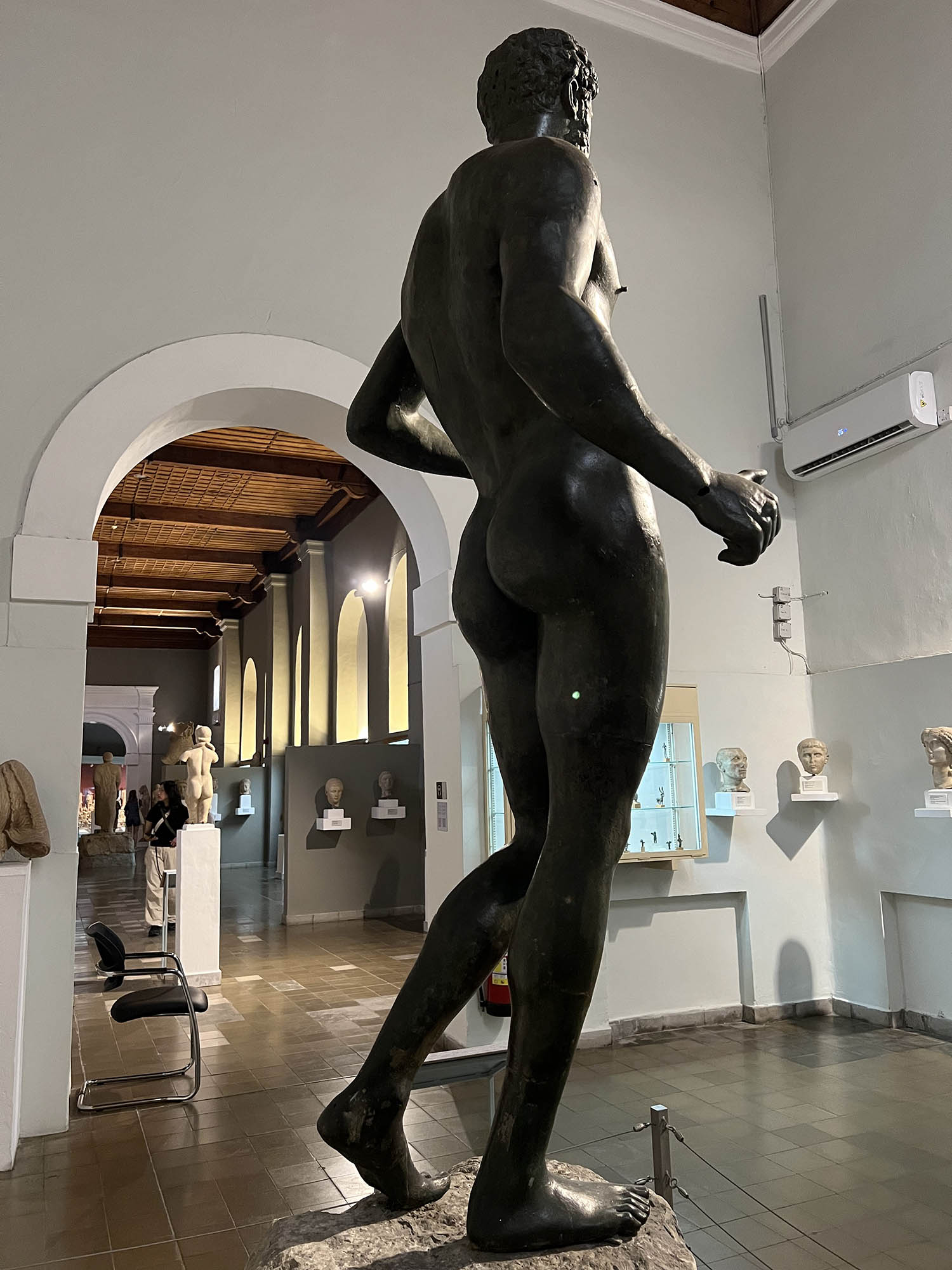
The museum also has an impressive collection of pottery, figurines, and tools.
Located near the Paphos Gate, it’s convenient to reach if you’re staying in or around the Old City. Entry is free (yet they'll still dispense a ticket), and it’s a perfect place to spend an hour or two when the heat gets too much if you're visiting in summer.
The Venetian Walls
The Venetian Walls encircle the Old City in a nearly perfect circle. Rebuilt in the 16th century to protect against Ottoman sieges, the walls are still intact, though they now frame a city split in two.

Walking along sections of the walls, I could see how the past still defines Nicosia’s present. Famagusta Gate, for example, has been turned into a cultural venue.


It’s practical to combine a walk around the walls with visits to the nearby old streets and squares.
Paphos Gate (Western End of Venetian Walls)
Paphos Gate is one of three original entrances built into the Venetian walls of Nicosia, a historical marker that has stood since 1567.
Designed by the Venetian military engineer Giulio Savorgnano, it was strategically placed as part of the fortifications surrounding Lefkosia (Nicosia) during a time of heightened Ottoman threats. Its name comes from the road that once began here, leading southwest toward Paphos.

Walking up to the gate, I was struck by its simplicity — an arched opening in the wall topped with a barrel vault. Yet, it tells so many stories.
Before the Venetians, this spot hosted a gate from the Frankish era, named "Porta di San Domenico" after the nearby Abbey of San Domenico. The Venetians replaced it with what we now call Paphos Gate, ensuring the city remained fortified against impending sieges.
In 1878, during British rule, a section of the walls near the gate was demolished to create a new opening for easier access to the city. This practical change reflects the evolving needs of the city over centuries.

Adjacent to the gate is the Paphos Gate Police Station, adding another layer to the site’s significance.
Although it is no longer a border crossing, the gate remains an evocative reminder of the city’s defensive past.
Standing here and taking photos, I could sense how the gate once framed the city’s relationship with the outside world, connecting Nicosia to trade routes and neighbouring towns.

If you’re exploring the Venetian walls, Paphos Gate is an unmissable stop, especially for history enthusiasts. Its westward location makes it a logical starting point for a walk that traces the walls toward the eastern Famagusta Gate.
The Green Line
Leaving Paphos Gate behind, I found myself walking along a route that felt as much a historical lesson as it was a physical journey. More than a line on a map, it’s a space that tells stories of a city caught between past and present.

The route was lined with remnants of a time before the divide: faded UN signage, barbed wire fences, and murals bearing powerful messages like "Remember Cyprus."
Some walls carried art and photographs, while others seemed overtaken by nature, with greenery growing defiantly through cracks. One sign in particular, depicting the island of Cyprus with a bleeding wound, stood out to me as both a protest and a plea.
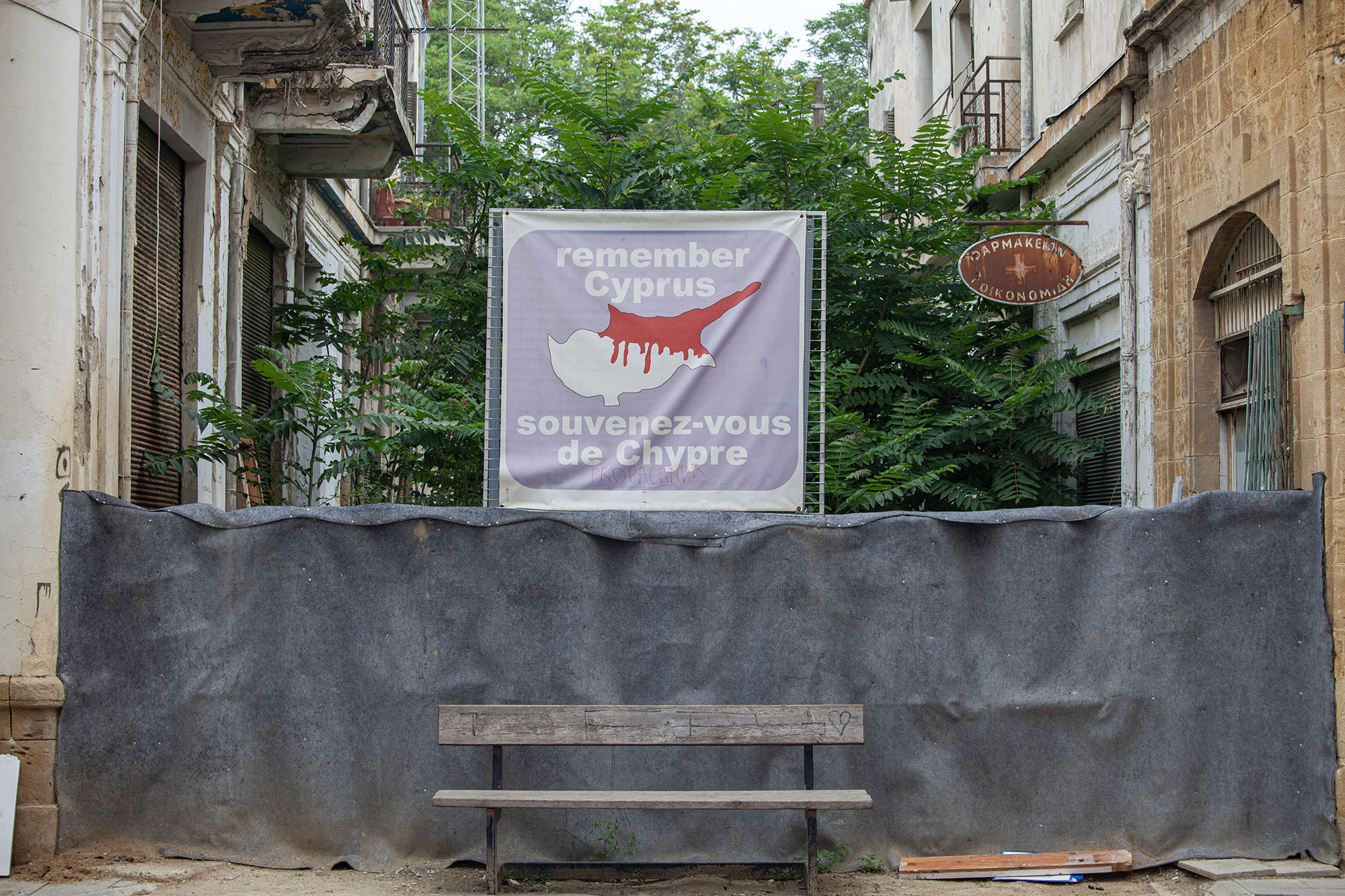
Abandoned buildings and barricaded streets served as stark reminders of the frozen state of this area since the conflict in the mid-20th century.
The silence here felt different — charged, almost sacred. Yet, life persists. There are small gardens and newer elements along parts of the line, showing signs of resilience and hope.

As I walked further toward Ledra Street, the juxtaposition between this quiet, reflective path and the lively energy of the Old Town was striking. The Green Line isn’t just a boundary; it’s a conversation — one that reminds visitors of the past but also points to the possibility of reconciliation and growth.

This part of Nicosia left a lasting impression on me. Whatever your reason for visiting, walking along the Green Line is an experience that deepens your understanding of the city and its people.
The Old City (aka Old Town)
I spent the next part of the day exploring the Old City, which included stopping at a small shop where a craftsman was making leather sandals. He chatted with me as he worked, and I left with a pair I’ll probably wear for years - details below.

In a nearby store, I ended up talking with a man and his father about life in Nicosia.

Even a driver passing by beeped and waved — it caught me off guard but added to the sense that this part of the city thrives on everyday connections.
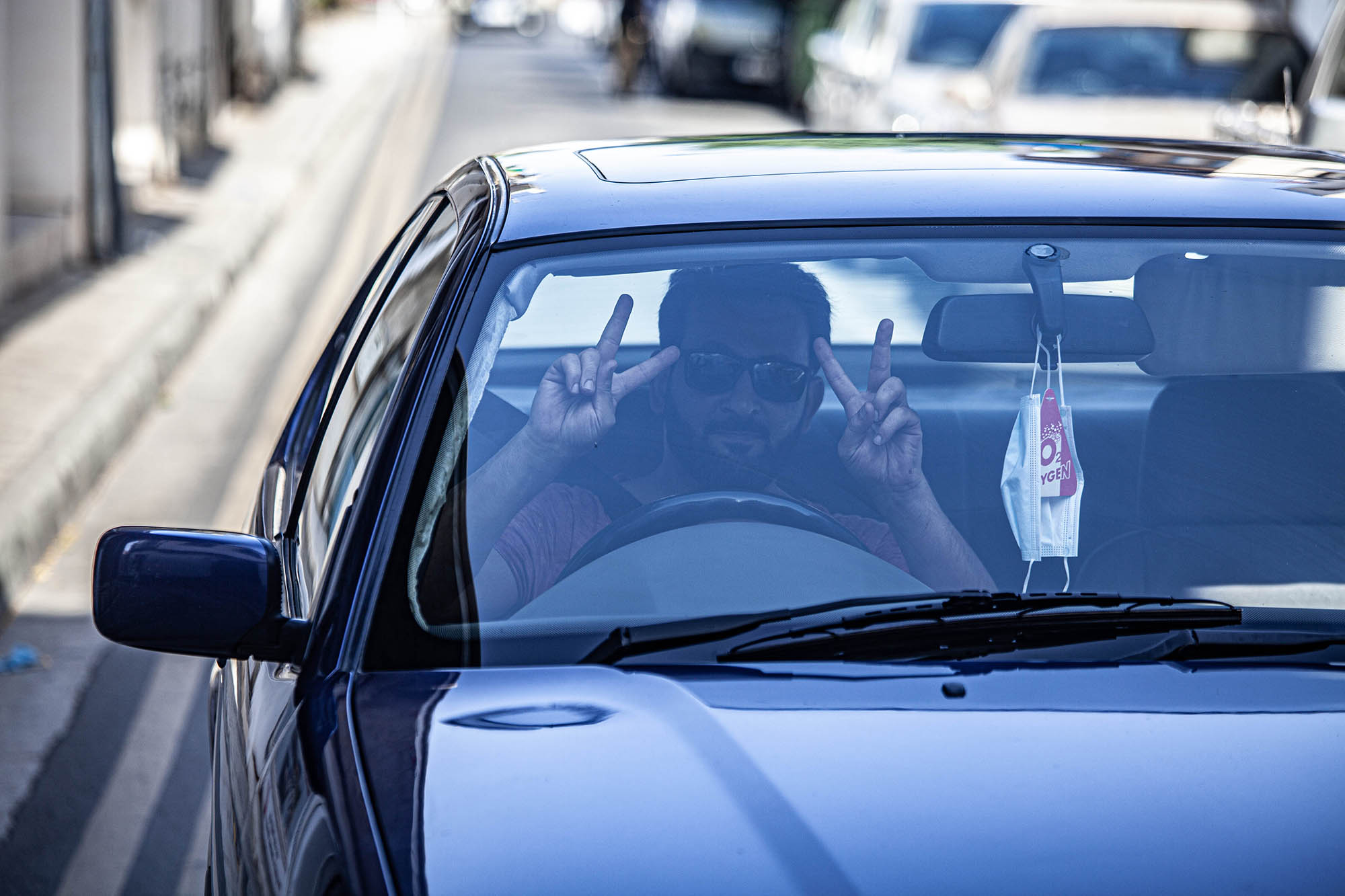
The Old City is the area within the Venetian Walls, stretching roughly from the southern end of Ledra Street to the Green Line crossing in the north, as well as east and west. It’s a compact space, easy to explore on foot, with highlights like Laiki Geitonia — a restored neighbourhood filled with shops and cafes — and churches such as Faneromeni.
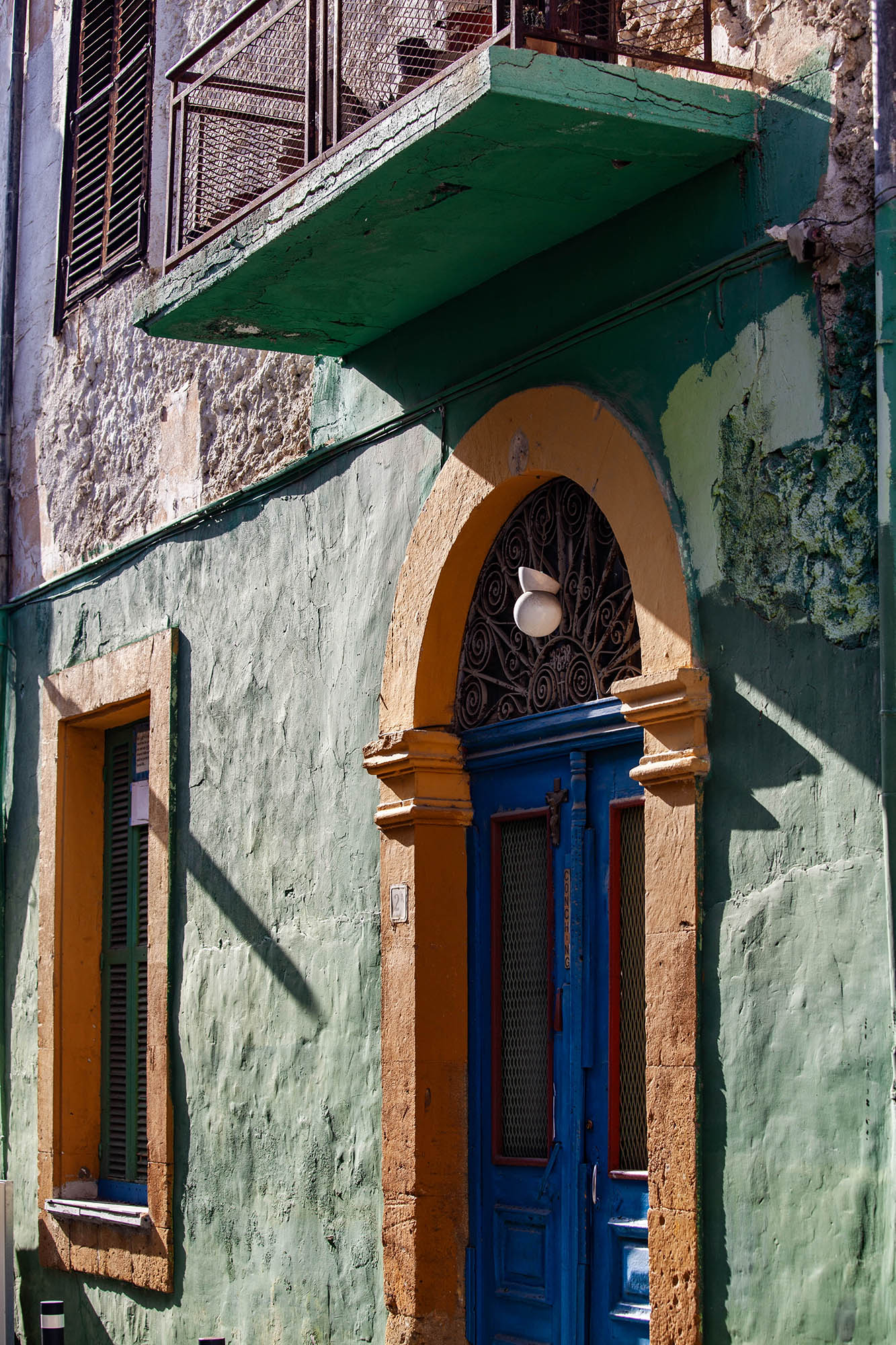

You’ll also find reminders of the city's division, with barbed wire and abandoned buildings along the Green Line.
Plan to spend a few hours here, whether you’re browsing the markets, visiting museums, shopping, dining, or simply following the rhythm of the streets.

Note: Many of the sights I’ve listed under their own headings, such as Ledra Street, Shacolas Tower, Hamam Omerye, and more, are also within the Old City, so you’ll naturally encounter them as you wander through this area.
Ledra Street
Ledra Street is where you'll find a pedestrian zone lined with shops, cafes, and street performers. This bustling street stretches through the heart of the Old City, offering a lively contrast to the more subdued corners nearby.

As I walked down the street, the atmosphere was energetic, with locals and tourists weaving their way in and out of shops and restaurants.

From quirky boutiques to international stores, Ledra is a place where you can shop, grab a coffee, or simply people-watch.

The street is also home to one of the key crossings into the Turkish-occupied northern side of Nicosia. At the Green Line Ledra Street checkpoint, I saw people presenting their IDs to cross over — a striking reminder of the island's divided status. Just seeing the border at street level made me reflect on the complexities of life here.
If you're looking for a spot to rest, there are shaded areas and benches along the way. And don’t forget to look up — some buildings retain their historic facades.


Ledra Street is a microcosm of Nicosia’s evolving identity.
Shacolas Tower Museum and Observatory
The Shacolas Tower Museum and Observatory offers one of the best views of Nicosia, making it a must-visit for anyone exploring the Old City.
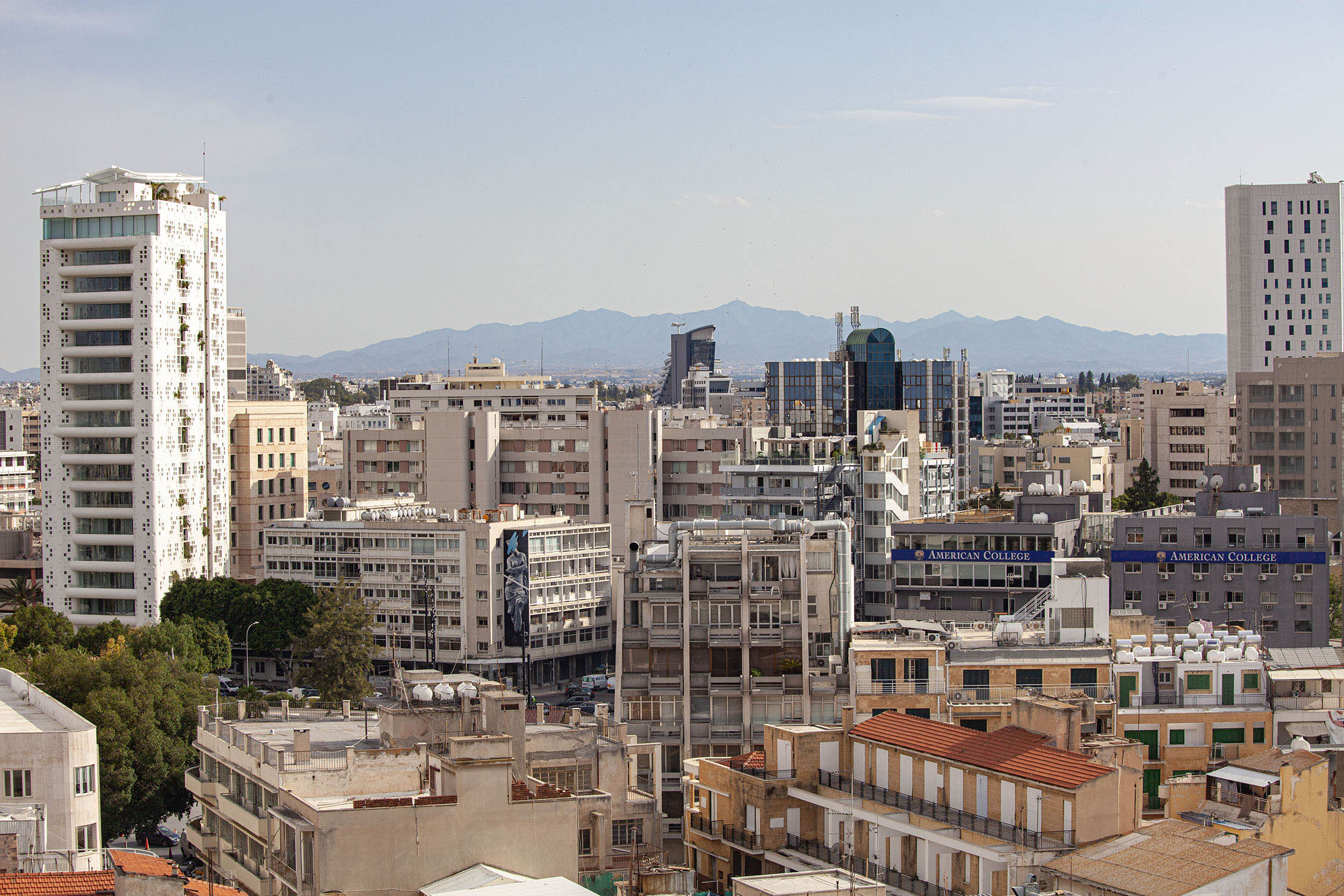
Located on the 11th floor of a building just off Ledra Street, it provides a panoramic perspective of the divided city, allowing you to see as far as the Troodos Mountains on a clear day.
Once you step onto the observatory platform, you'll find telescopes to help you spot landmarks in both the Greek Cypriot-controlled south and the Turkish-occupied north. Information boards highlight key points of interest, giving you a deeper understanding of the city’s history and geography.

What makes the Shacolas Tower special isn’t just the view but the quiet opportunity to reflect on Nicosia’s complex narrative of division and resilience.
While there, I found myself drawn to the contrast between modernity and history — gleaming office towers on one side and crumbling facades on the other.

The layers of graffiti visible from above add a gritty, artistic dimension to the cityscape.
Practical Information
- Opening Hours: The Shacolas Tower is generally open daily from 10 AM to 5 PM, though hours vary during holidays.
- Accessibility: The building has an elevator, making it accessible to all visitors.
- Location: It’s located on Ledra Street, easy to find while strolling through the Old Town.
Set aside 20–30 minutes to soak up the view and capture some photos. It’s a peaceful break from the busy streets below and a great spot to get your bearings.
Eleftheria Square
Eleftheria Square, also known as Freedom Square, is not just a transit point within Nicosia but a vibrant space that merges history, modern architecture, and community life.

Designed by Zaha Hadid, the square has undergone a stunning transformation, making it a prominent landmark.
As I walked through the square, the contrasts struck me — on one side, you see remnants of the Venetian walls that mark the Old City, while on the other, sleek modernist designs create a fresh, open public space. The plaza’s sunken levels and surrounding greenery invite you to linger, making it a gathering point for relaxation and people-watching.

I was lucky to visit at sunset, when the lighting accentuated the interplay between the old city’s stone walls and the contemporary architecture.

Families strolled along, children played on scooters and devices, and cyclists wove around the space.


In the middle of the square, public art installations added depth, drawing curious onlookers to stop and reflect.


At the edges of the square, cafes and restaurants offer refreshments and a front-row view of the activity.
It's a great spot to take a break before continuing your exploration of Nicosia.
Hamam Omerye
I came across Hamam Omerye during my wanderings in the Old City, and while I didn’t have the chance to try it out, stepping inside gave me a glimpse of its intrigue.
This 14th-century building, once part of an Augustinian monastery, was converted into a bathhouse during Ottoman rule, and today, it’s one of Nicosia’s most atmospheric spots.

The soft lighting, stone arches, and gentle sounds of water made the space feel like an oasis in the heart of the city. I could see why it’s popular for those looking to unwind.
The prices, though, were a little above my budget for the trip but that didn’t stop me from taking a moment to appreciate the care that’s gone into preserving the site.
Even if you don’t go in for a treatment, Hamam Omerye is worth a quick visit to admire its architecture. It’s a place that captures the city’s slower, restorative side — something I’ll definitely make time for if I return to Nicosia.
Saint/Apostle Barnabas Cathedral
Another stop on my itinerary was Saint Barnabas Cathedral.

Named after one of the founders of the Cypriot Church, the cathedral carries a legacy tied to the island’s deep Christian history. Saint Barnabas, a native of Cyprus and an early companion of Saint Paul, is considered a patron saint of the island.
The exterior of the cathedral is intriguing. Inside, the atmosphere shifts to one of quiet reverence, with simple but meaningful features, including iconography depicting Saint Barnabas and scenes from his life.
It’s said that Barnabas was martyred on the island after spreading Christianity in the region, making this spot a symbol of the enduring faith of the Cypriot people.

I didn’t linger too long — just enough to take in the peacefulness and reflect on its significance before moving on.
The House of Hadjigeorgakis Kornesios
After visiting Saint Barnabas Cathedral, I headed to the House of Hadjigeorgakis Kornesios, an 18th-century Ottoman-era mansion in the Old City. Once home to Hadjigeorgakis Kornesios, a powerful dragoman (interpreter) under Ottoman rule, the house offers a glimpse into life during that time.
The mansion’s wooden ceilings, carved details, and traditional courtyard reflect Ottoman architectural elegance. Inside, highlights include a private hammam and restored rooms filled with period furnishings.

It’s fascinating to think that Kornesios, as a mediator between the Ottoman administration and the Greek Cypriot population, held great influence — until accusations of betrayal led to his execution in 1809.
Now a museum, the house is a quiet but worthwhile stop. It doesn’t take long to visit, but it leaves a lasting impression of the city’s rich past.
Liberty Monument and Podocatoro Bastion
As my exploration of Nicosia continued, I came across the Liberty Monument, located near the Podocatoro Bastion on the eastern edge of the Venetian Walls. Built in 1973, this monument commemorates Cyprus's struggle for independence from British colonial rule.

The monument is an intriguing mix of symbolism and history. At its base, prisoners emerge from underground cells, representing the anti-colonial fighters, while two heroic EOKA fighters pull chains to open a prison gate, symbolising the struggle for independence. The statue of Liberty, perched at the top, ties the imagery together.
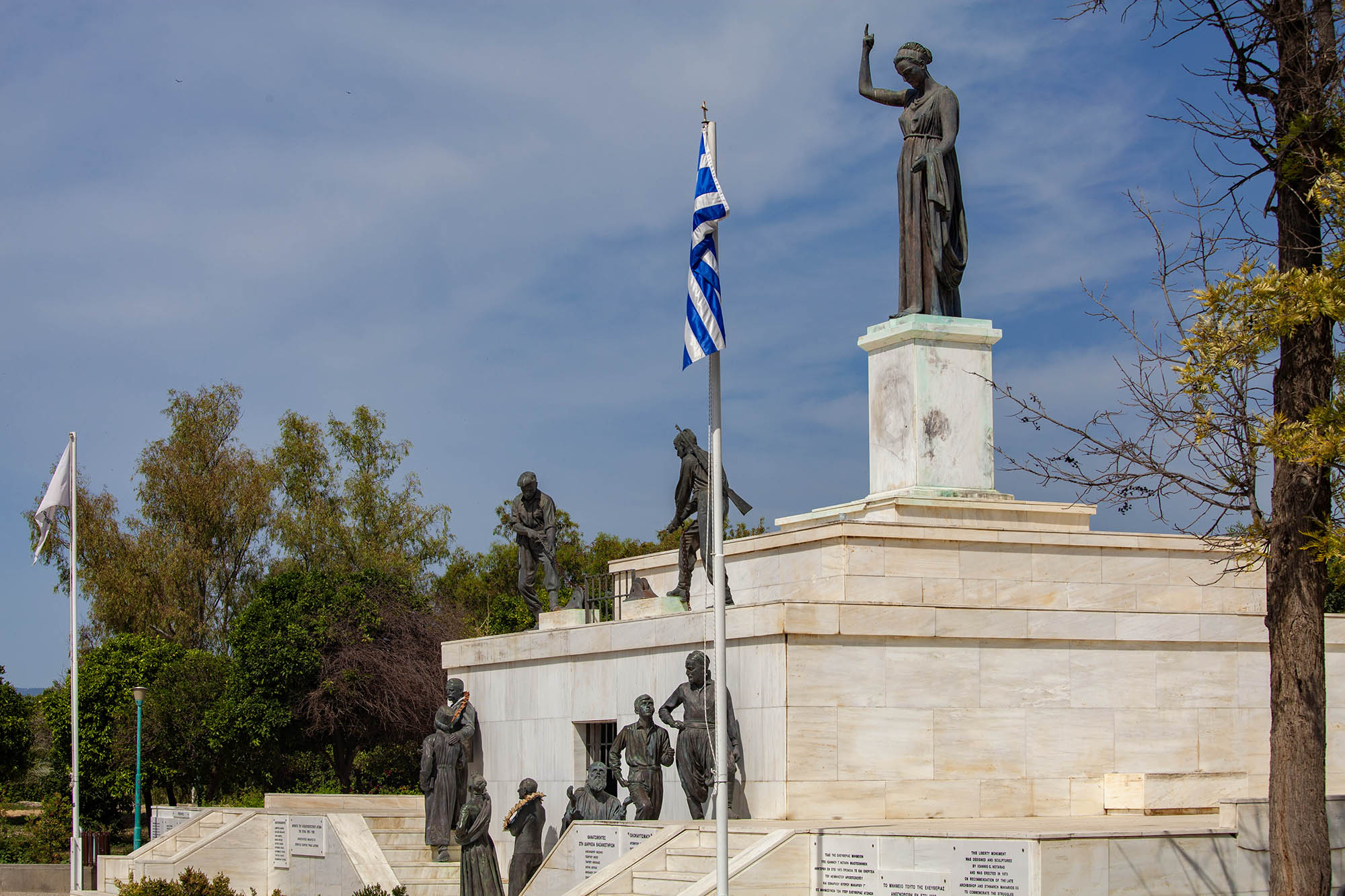
The surrounding 16th century Podocatoro Bastion serves as a reminder of Nicosia's strategic importance throughout history.
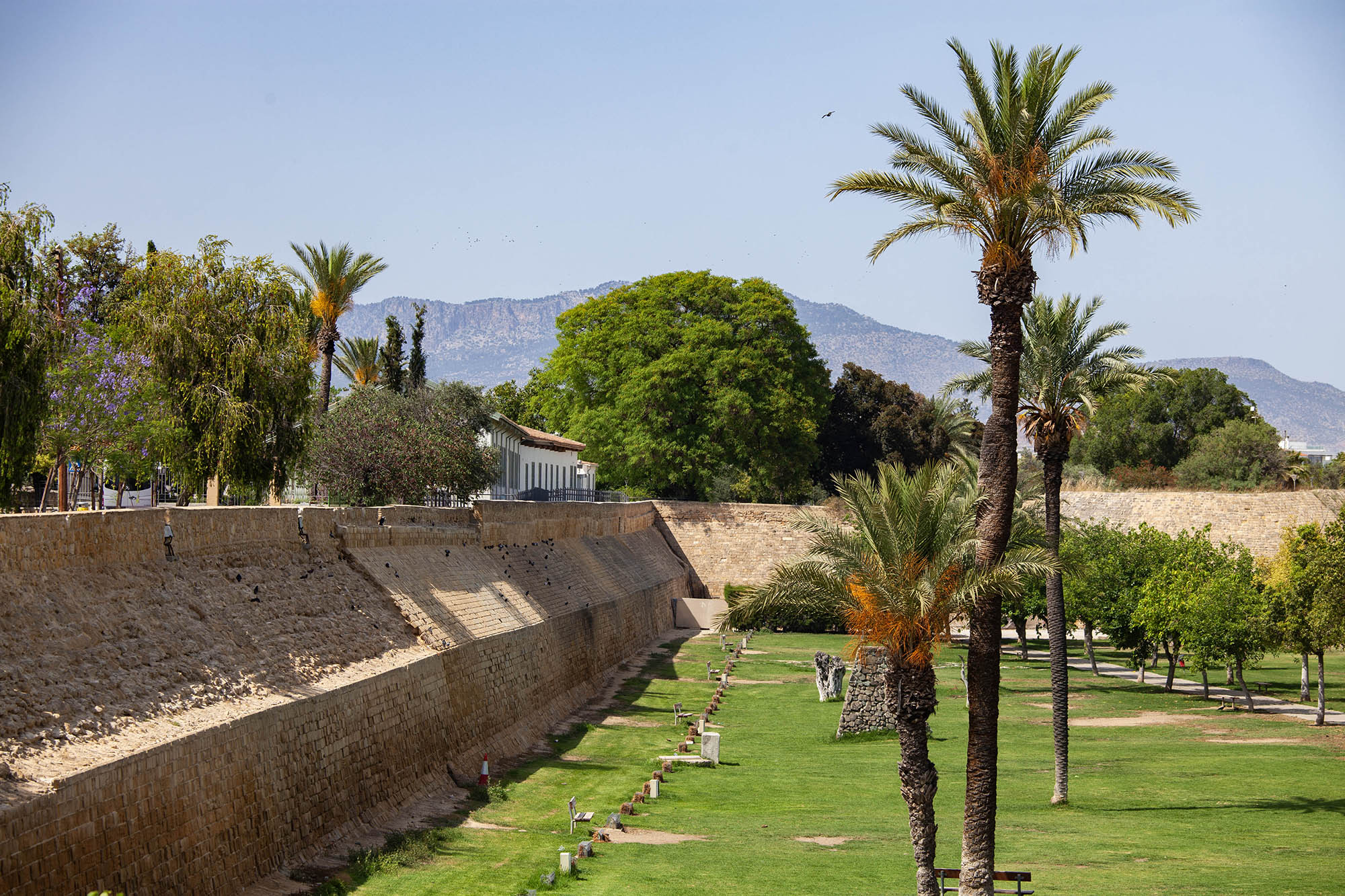
Standing here, surrounded by both history and symbolism, I took a moment to appreciate the immensity of Nicosia’s past - so much has happened here.
Then, it was time to move on to the next discovery.
Nicosia Old Aqueduct
I then saw the Old Aqueduct — a piece of history that quietly blends into the modern city. Built during the Venetian period, this aqueduct was a vital structure, channeling water to the walled city from the nearby Pentadaktylos Mountains.

The remains of the aqueduct are modest, yet their historical significance is compelling. It’s curious to think about how this infrastructure once supported daily life in Nicosia, from the public fountains to the private homes within the Old City.
Though it’s not as grand as other aqueducts you might find in Europe, its simplicity and functionality offer a glimpse into the ingenuity of the time.
Famagusta Gate (Eastern End of Venetian Walls)
On the eastern side of the Venetian Walls, I approached Famagusta Gate, one of the three original entrances to the walled city.

Built in the 16th century by the Venetians as part of their fortifications, it once served as a vital gateway for those entering Nicosia from the east, particularly from the port city of Famagusta.
Today, the gate no longer allows you to step through to the other side, but its imposing stone archway and barrel-vaulted design remain. Standing in front of it, I couldn’t help but think of those who once did pass through here.

Repurposed as a cultural centre, the gate now hosts exhibitions, performances, and events. If you're lucky, your visit might coincide with something happening inside, offering a unique chance to experience this place in a new light.
It’s worth checking if there’s an event on when you visit.
Ektoros Street
Ektoros Street wasn’t somewhere I planned to visit, but I’m glad I stumbled across it. The murals along the walls caught my eye first — some faded, others freshly painted. One, of hands holding a map of Cyprus, stood out to me, even with its peeling paint.

The workshops along the street added to its character. I passed a carpenter quietly working on a piece of wood, barely glancing up as I walked by. It felt less like a tourist attraction and more like a snapshot of everyday life.


There were also a few cats lounging around, one perched atop a bin like it owned the place. The street had a lived-in feel — nothing flashy, just a space that seemed to breathe its own rhythm.

It’s not a must-see, but if you’re nearby (and it's very close to Famagusta Gate), it’s worth a quick look to see a quieter, creative side of the city.

For me, it was a nice break from the busier parts of Nicosia such as Ledra Street.
Old Town Hall Archaeological Site/Archaeological Site of Palaion Demarcheion
Walking back towards Ledra Street from Ektoros Street, I came across a small archaeological site (also referred to as archaeological park) tucked away near the heart of the Old Town. The sign called it the Old Town Hall Archaeological Site — or was it the Archaeological Site of Palaion Demarcheion? I’m not entirely sure, and I didn't photograph the sign, but either way, it caught my attention.

It’s not an enormous site, more like a fenced-off area with some well-preserved ruins. I didn’t linger too long, but it was interesting to see the remnants of what must have been important buildings in the city’s history (from Byzantine and Medieval periods, I believe). The contrast of ancient stone foundations with the modern surroundings made me pause for a moment.
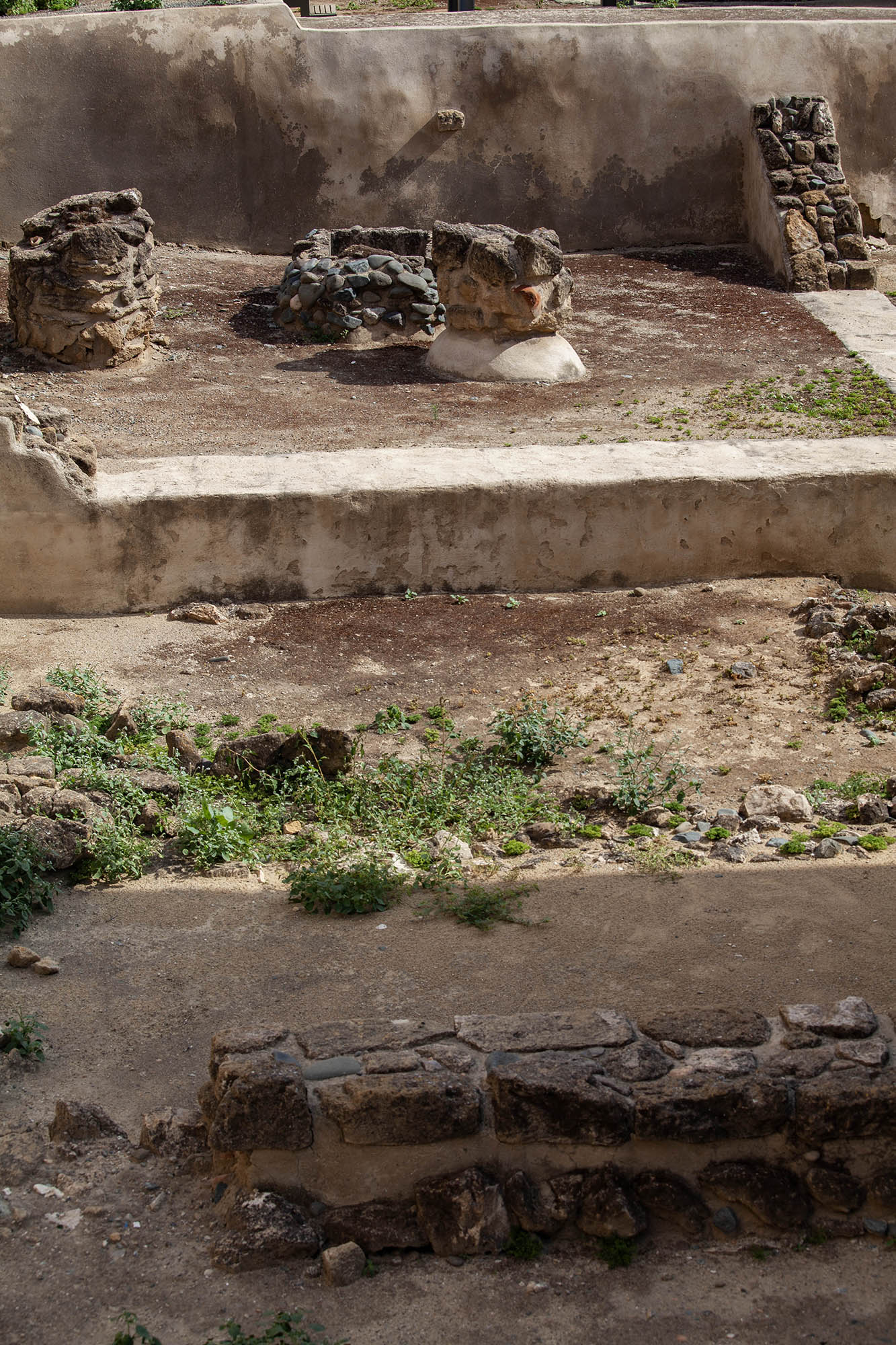
If you’re passing by, it’s worth a glance, though I wouldn’t go out of my way to find it unless, of course, you're a historian or historical enthusiast. It’s one of those details that adds to the story of Nicosia. For me, it was a nice detour before heading back to the busier streets.
Cypriot Sandals
While wandering through the Old City, as mentioned earlier, I stumbled upon Astir Leather Sandals, a small, unassuming shop that instantly caught my eye. The scent of leather and the rows of meticulously crafted sandals beckoned me in.
Behind the counter stood the craftsman himself, surrounded by photographs and materials — a living testament to his trade.

He greeted me with a warm smile and began sharing stories as he worked. I learned that Cypriot leather sandals, akin to the styles worn in Roman and Greek times, are something of a local specialty. Each pair is handmade, designed to last, and exudes a timeless simplicity.
I couldn’t resist picking up a pair — sturdy yet stylish, with a fit that felt like they were made just for me. As I slipped them on, I knew these would be more than just shoes; they’d be a lasting memory.

If you’re in the Old City, I highly recommend stopping by this shop. Even if you’re not in the market for sandals, the conversation and glimpse into this enduring craft are well worth the visit.
Plus, who doesn’t love a souvenir you can actually use?
Save this article for future reference!
Highlights of Northern Nicosia (Turkish-Occupied)
Northern Nicosia feels different from the southern side, with its Ottoman-era architecture, bazaars, and distinct cultural atmosphere. Crossing the Green Line, you’ll notice the change in language, currency, and vibe, offering a unique opportunity to experience two contrasting sides of the same city.
If you’re like me and enjoy wandering aimlessly to discover hidden corners, the north’s lively streets will reward you. But if you’d prefer a deeper dive into its history and culture with someone to guide you, a walking tour of Northern Nicosia is a fantastic option. This tour takes you through landmarks like Büyük Han and Selimiye Mosque while providing insights into the area’s past and present.
➡️ Click here to book a guided Walking City Tour of Northern Nicosia
Buyuk Han (The Great Inn)
Büyük Han, one of the first landmarks you’ll likely encounter after crossing into northern Nicosia, is a beautifully preserved example of Ottoman architecture.

Built in 1572 as a caravansary — a roadside inn for merchants and travellers — it served as a hub of trade and hospitality. The courtyard, with its central domed mosque and fountain, offers a glimpse into a time when the Han was bustling with traders from all over the region.
When I visited, I spent time wandering through the small shops and galleries that now occupy the former rooms of the inn. Many sell handmade crafts, jewellery, and artwork, giving it a lively, creative feel.
Plan to spend at least an hour here, exploring the unique blend of history and contemporary culture. Don’t miss climbing the stairs to the upper level, which provides a great view of the courtyard and a chance to appreciate the architectural details up close.
Kumarcilar Inn
Kumarcılar Inn, located a short walk from Büyük Han, is another piece of history in northern Nicosia. Built in the late 17th century, this smaller Ottoman caravansary once provided lodging for merchants and their goods.
Unlike the more bustling Büyük Han, Kumarcılar Inn feels quieter and more intimate, with its compact courtyard and arched stone structures.
When I visited, the restoration work was evident, but parts of the inn retain a sense of the past, with a few shops and artisans setting up in the lower rooms. It doesn’t take long to explore, but the peaceful atmosphere makes it worth a stop.
Combine a visit here with Büyük Han to appreciate the contrast between the two inns and their roles in Ottoman-era Nicosia.
Selimiye Mosque (Former St. Sophia Cathedral)
Selimiye Mosque, originally St. Sophia Cathedral, is a striking landmark in northern Nicosia. Built in the 13th century as a Gothic cathedral during the Lusignan period, it was later converted into a mosque by the Ottomans in the 16th century.
The blend of Gothic and Islamic architectural styles is unique, with soaring pointed arches, intricate stone carvings, and the addition of minarets flanking the entrance.

Walking inside, I was struck by how the space has transformed over time — stained glass windows and vaulted ceilings remain, but the interior is now simple, with prayer mats lining the floor and a mihrab pointing toward Mecca.
This is a working mosque, so visitors should dress modestly and remove their shoes before entering. Take a moment to admire the façade and the surrounding area, which is lively with markets and cafes, making it easy to combine a visit here with other nearby attractions like Büyük Han.
Bedesten (Church of St. Nicholas)
Bedesten, originally the Church of St. Nicholas, is an example of Nicosia’s enduring story. Built in the 6th century during the Byzantine era, it was later expanded under the Lusignans and eventually converted into an Ottoman marketplace.
Today, it serves as a cultural and event space, showcasing its rich architectural blend of Byzantine, Gothic, and Ottoman influences.

When I visited, the serenity of the building stood out. The interior, with its vaulted ceilings and stone arches, was a quiet reminder of the building’s long story and changing purpose.
Some exhibitions and events are hosted here, so it’s worth checking what’s on during your visit.
Located near Selimiye Mosque, Bedesten is easy to add to your northern Nicosia itinerary. Spend some time appreciating its unique architectural details.
Rüstem's Bookshop
I stumbled across Rüstem’s Bookshop entirely by accident — I needed to use a toilet, went in to ask, and ended up being pleasantly surprised. The bookshop, a five-minute walk from Bedesten, has a nostalgic feel with its mix of English, Turkish, and Greek books, as well as postcards and prints.
One feature that caught my attention was the spiral staircase, winding its way up behind shelves brimming with books — a striking combination of functionality and charm.


After browsing for a while, I stayed for a drink at the cosy café in the back courtyard, which turned out to be a peaceful little oasis.
It’s the kind of spot where you can take a break from sightseeing, soak in the relaxed atmosphere, and maybe pick up a meaningful souvenir or two.
Turkish Delight
While I didn’t eat a full meal in northern Nicosia, I did have an unexpected sweet moment when a shopkeeper near the Green Line offered me a piece of Turkish delight.

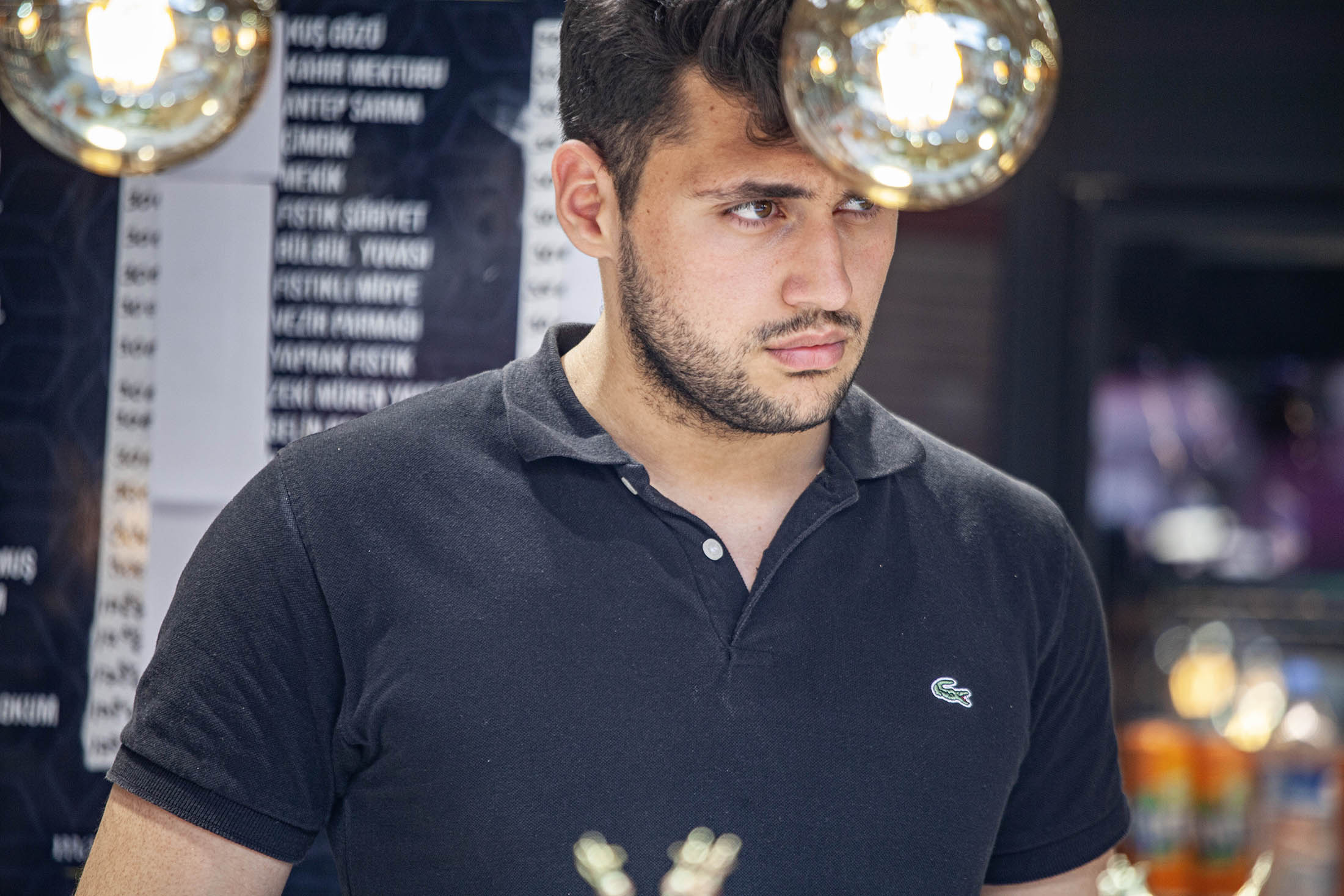
It was a small but generous gesture, and the display of stacked trays filled with powdered cubes immediately caught my eye.

If you’re crossing into the north, take a moment to browse the stores near the checkpoint — many sell Turkish sweets and snacks that make for a quick treat or gift.
Street Art and Everyday Scenes
Northern Nicosia isn’t just about historical landmarks — it’s also home to modern creativity and glimpses of daily life. I came across a striking mural of a hand holding a glass on a crumbling brick wall, blending art with the texture of the city’s past.

A little further along, I spotted a man working methodically with stones, a quiet moment that felt rooted in the rhythms of local life.
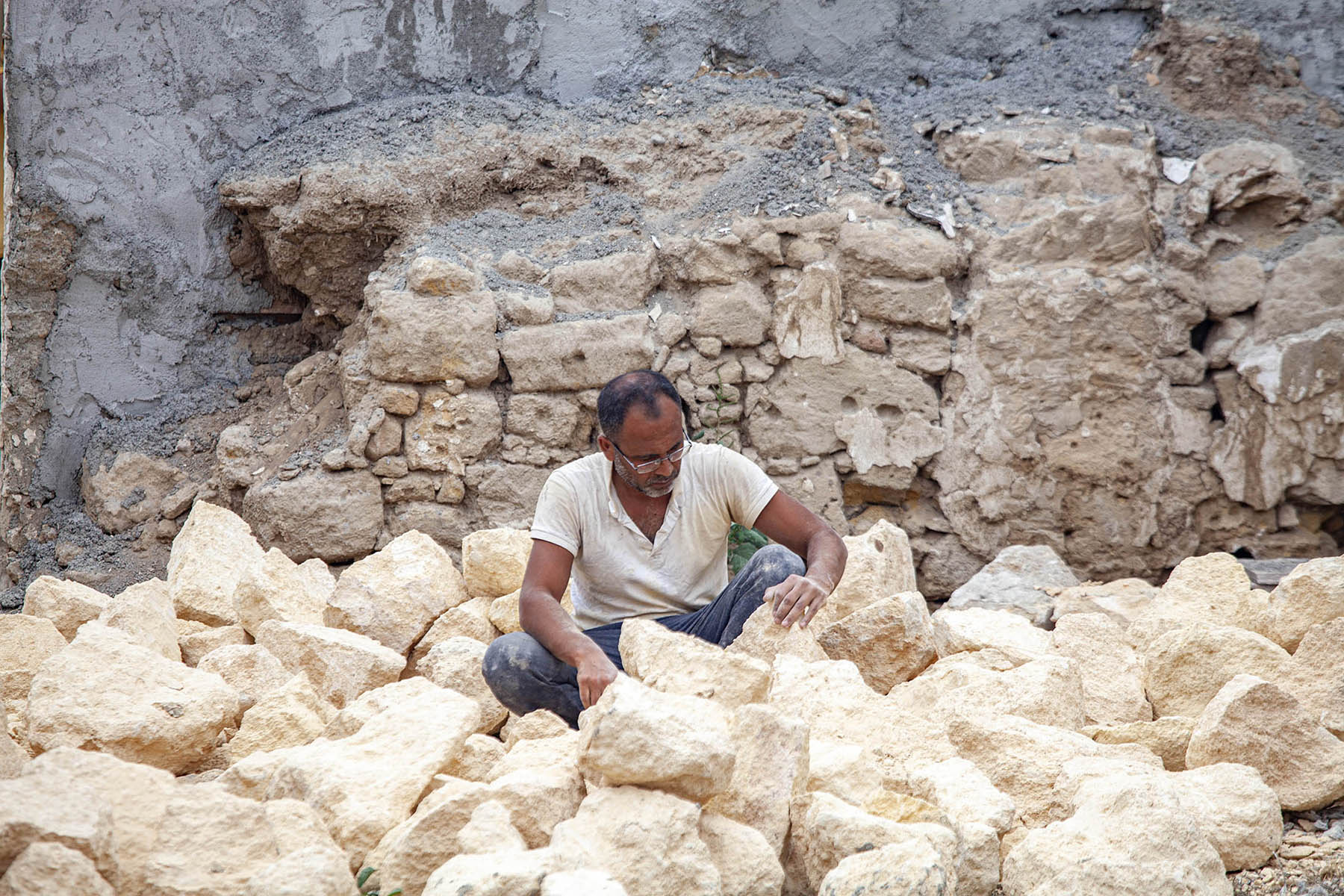
These kinds of discoveries show there is more to see beyond the well-known sights like Büyük Han and Selimiye Mosque. Take a random turn now and then — you might stumble across something equal measure unexpected and meaningful.
Tips for Visiting Northern Nicosia (Turkish-Occupied)
Exploring Northern Nicosia offers a distinct perspective on the city's history and culture, but a few tips will enhance your visit.
Crossing the Green Line
Make sure to carry your passport, as it’s required to cross the Green Line at checkpoints like Ledra Street. The process is straightforward and usually quick, but be mindful of operating hours, as crossings are not 24/7.
Crossing the Green Line is an experience that makes Nicosia worth visiting for those interested in understanding the complexity of its divided identity. It’s not just a political border but a window into the island’s contrasting cultures.
Currency and Payments
The currency in the north is the Turkish lira (₺), but euros can be accepted in some heavily touristed areas. Carry small denominations, as credit card use is occasionally limited in smaller shops and cafes. I found this out the hard way.
Dressing Modestly
When visiting places like Selimiye Mosque or other religious sites, dress modestly to show respect. Shoulders and knees should be covered, and shoes must be removed before entering mosques.
Language
While Turkish is the primary language spoken in Northern Nicosia, many people in tourist areas speak basic English. Learning a few Turkish phrases can be a nice gesture and make interactions smoother.
Food and Drinks
Try local specialties like Turkish coffee, kebabs, and baklava. Cafes around Büyük Han or near Selimiye Mosque are great for a quick break, and you might even find a shopkeeper offering you a piece of Turkish delight to sample.
Being Sensitive About the Division
The division of Cyprus is a deeply personal and complex issue for many people, so it’s best to approach the topic with sensitivity. While some locals may be open to sharing their perspectives, others might prefer not to discuss it at all.
I asked a few shop owners on both sides about their thoughts, using the question, 'Do you think the city will ever be reunited?' It was a non-confrontational way to prompt discussion, and their answers varied — from hopeful to resigned — but everyone appreciated that I asked respectfully and listened without judgment.
If you’re curious, listen respectfully and avoid making assumptions or taking sides in the conversation.
Is Nicosia Worth Visiting for You?
Nicosia offers something for everyone, but whether it’s worth visiting depends on your interests.
History Buffs
Nicosia’s history is on full display, from the ancient artefacts in the Cyprus Museum to the 16th-century Venetian Walls that encircle the Old City. The Green Line dividing the city adds a unique and poignant perspective, blending historical significance with contemporary realities.


If you enjoy exploring places where history is still alive, Nicosia won’t disappoint.
Culture Lovers
Straddling two cultures, Nicosia is a fascinating blend of Greek-Cypriot and Turkish-Cypriot traditions. Crossing the Green Line allows you to experience both sides, from the markets of northern Nicosia to the streets of the south.


It’s a city where the duality of cultures is part of its daily rhythm.
Food Appreciators
Nicosia is a treat for food enthusiasts, with traditional Cypriot tavernas, Turkish-inspired dishes, and a growing modern cafe scene. Whether you’re sampling halloumi in the south or enjoying fresh baklava in the north, the city offers plenty of culinary delights.


Don’t miss the chance to explore both sides of the border for a full flavour experience.
Solo Travellers
Nicosia is an excellent destination for solo travellers, offering a mix of historic sites, walkable streets, and plenty of cafes for downtime. Hostels in the city make it easy to meet fellow travellers, while the city’s laid-back atmosphere ensures you’ll feel at ease exploring alone.


It’s a city where you can move at your own pace.
Nature Seekers
While Nicosia itself ISN'T known for its natural landscapes, it could be used as a base for day trips to explore Cyprus’s diverse scenery. From here, you can head north to the Kyrenia Mountain Range for stunning coastal views or reach the Troodos Mountains, with their hiking trails and villages.
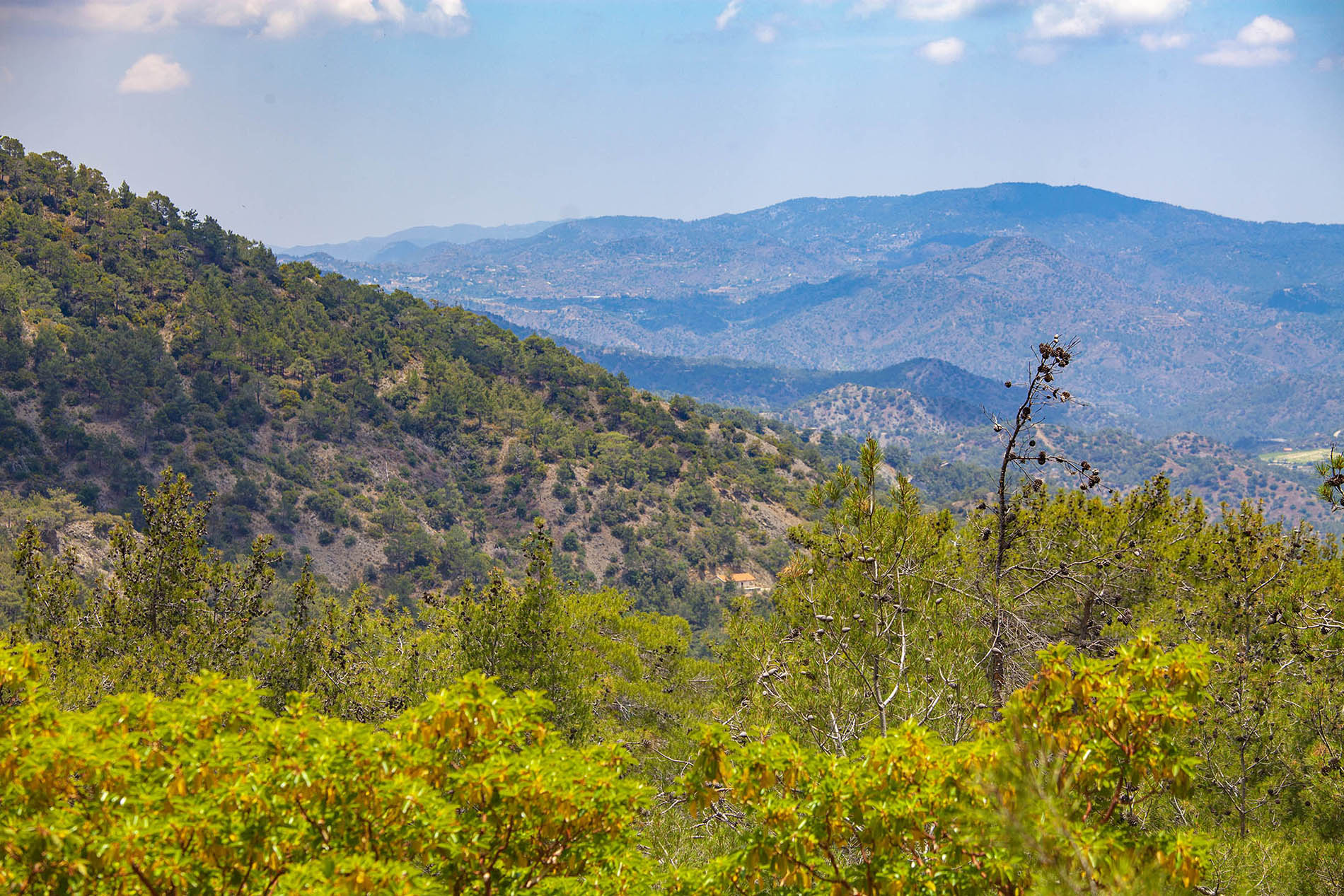
Within the city, small parks offer a quiet escape from the urban setting.
Beach Enthusiasts
Nicosia is NOT a beach destination, but its central location makes it a starting point for day trips to the coast.

The beaches of Larnaca, Limassol, and the more secluded ones in northern Cyprus are all within an hour or two’s drive. If you love combining city exploration with a beach getaway, Nicosia could work — but in my opinion, there are better options for beaches, like Larnaca and Paphos in the south or Girne and Famagusta in the north.
Save this article for future reference!
Practical Tips for Visiting Nicosia
When I was planning my trip to Nicosia, I had some questions — about transportation, where to stay, and how long to spend there — so here’s what I learned.
Transportation: Getting to Nicosia
There are several ways to get to Nicosia, depending on where you’re coming from. Here are the main options.
By Bus
I took the Intercity Bus from Larnaca (departing from the Finikoudes stop along Larnaca Marina), which was straightforward and budget-friendly. Buses connect major cities like Larnaca, Limassol, Ayia Napa and Paphos to Nicosia. The trip from Larnaca takes 1 hour and 15 minutes, and tickets are purchased directly from the driver.
Most buses drop you off at Solomou Square, near the city centre and within walking distance of the Old City.
By Car
Driving to Nicosia is a good option if you want more flexibility. The city is well-connected by highways, and parking is available near the Old City (but it harder to find within the Old City).
Keep in mind that Cypriots drive on the left side of the road.
From Northern Cyprus
If you’re coming from the northern side of the island, you can cross the Green Line at one of the checkpoints, like Metehan (by car) or Ledra Street (on foot).
Transportation: Getting around Nicosia
Getting around Nicosia is relatively straightforward, with options for walking, cycling, and public or private transport. Here’s a breakdown.
On Foot
Nicosia is very walkable, especially within the Venetian Walls and the Old City. The compact streets make it easy to explore on foot.
By Bicycle
Cycling is an eco-friendly and efficient way to get around Nicosia. There are bike rental services available, and the city has some dedicated cycling routes, particularly around Eleftheria Square.
Keep an eye out for traffic in busier areas, as not all streets have bike lanes.
By Bus
Buses are the main form of public transport in Nicosia, but they’re limited in frequency and routes. Most buses operate between the city centre and suburban areas, making them less practical for exploring within the Old City.
Tickets are inexpensive, and you can usually pay onboard.
By Taxi
Taxis are widely available and convenient for getting to places not easily accessible on foot or by bus. They operate on meters, but it’s worth confirming the fare before starting your trip.
Where to Stay in Nicosia
Staying within the Old City or close to it is ideal, as it puts you within walking distance of Nicosia’s main attractions.
Budget: NEX Hostel
This is where I stayed during my time in Nicosia. While slightly removed from the city centre (and outside the walls), the local neighbourhood provides a taste of Cypriot life, complete with a fantastic bakery nearby - I ate there at least twice.
There are clean and comfortable rooms, a large balcony and a well-equipped kitchen perfect for self-catering. With a friendly onsite manager who goes above and beyond to assist guests, NEX Hostel is an excellent choice.
Mid-Range: Unique City Centre Apartments
If you’re looking for a comfortable and practical place to stay in the heart of Nicosia, Unique City Centre Apartments is a solid midrange choice. Just a short walk from major attractions, in the Old City, these apartments are spacious and well-equipped, with everything from a fully functional kitchen to a washing machine — great for anyone planning a longer stay.
There's a private balcony and a cosy seating area, which make it easy to relax after a day of exploring.
High End: MAP Boutique Hotel
If you're looking for a luxurious stay in Nicosia, MAP Boutique Hotel offers a modern and stylish escape. The spacious rooms are thoughtfully designed, with private balconies and little extras like a coffee machine to make your stay feel special.
Its location is fantastic, across the road from D'Avilla Bastion and Eleftheria Square - you’re perfectly positioned to explore the city. With a fitness centre, an onsite restaurant, and glowing reviews, it’s a top pick for travellers wanting comfort and convenience in the heart of Nicosia.
Best Time to Visit Nicosia
The best time to visit Nicosia is during spring (March to May) or autumn/fall (September to November). These months offer mild temperatures, making it comfortable to explore the city on foot and enjoy outdoor attractions.
Summer can be very hot, with temperatures often exceeding 35°C (95°F), so it’s best to avoid midday heat if you visit during this time.
Winter (December to February) is cooler and quieter, but some outdoor activities might be less enjoyable due to occasional rain.
I visited during summer, and while the mornings, late afternoons, and evenings were bearable, the midday heat was intense. If you plan to visit in summer, schedule indoor activities like museums for the hottest part of the day and save outdoor exploring for earlier or later.
FAQs About Visiting Nicosia
During my time in Nicosia, I came across plenty of questions that travellers often ask, so I’ve gathered some answers to help you out
What’s the Difference Between Lefkosa and Nicosia?
Lefkosa and Nicosia refer to the same city, but the names are used differently depending on which side of the Green Line you’re on.
Nicosia is the name used on the southern (Greek Cypriot-controlled) side, while Lefkosa is the name used on the northern (Turkish-occupied) side.
Crossing between the two is straightforward, and both sides offer unique experiences worth exploring.
Can You Enter Southern Nicosia from Northern Nicosia if You Arrived via Northern Cyprus?
Yes, you can cross from Northern Nicosia to Southern Nicosia even if you initially entered Cyprus through the Turkish-controlled north, using checkpoints like the pedestrian crossing at Ledra Street. However, there are some important rules to keep in mind:
- Entry Legality: The Republic of Cyprus considers entry via the north (e.g., through Ercan Airport) to be illegal. While this isn't necessarily enforced for travellers, it could lead to complications.
- Documentation: Ensure you have a valid passport and any required visas. If you plan to leave Cyprus from the south to another EU country, it’s a good idea to have proof of your itinerary in case you’re asked.
- Potential Risks: In some cases, travellers have reported issues such as fines or difficulties at border crossings (being denied entry/exit).
To avoid complications, it’s generally recommended to enter Cyprus through the south if possible.
Is Nicosia Walkable?
Yes, Nicosia is very walkable, especially within the walled Old City.
The streets are compact, and most major landmarks, like the Cyprus Museum and Ledra Street, are within easy walking distance of each other.
However, if you’re exploring areas beyond the walls, like the Liberty Monument or neighbourhoods further afield, you will find yourself walking longer distances.
Comfortable shoes are a must, especially if you plan to wander through the cobblestone streets and quieter back alleys.
How Many Days Do You Need in Nicosia?
I spent four days in Nicosia, which felt like the perfect amount of time.
This included exploring the main sites in southern Nicosia, visiting northern Nicosia, and taking two day trips to Famagusta and Kyrenia on the northern side of the island.
If you’re only focusing on the city itself, two full days should be enough to cover the highlights without feeling rushed.
What's the Best Way to Spend a Day in Nicosia as a Tourist?
If you only have one day in Nicosia:
- Start at the Cyprus Museum to get a sense of the island’s history
- Head to the Old City to explore the Venetian Walls, Ledra Street, and Shacolas Tower for a panoramic view
- Walk along the Green Line to see the city’s division up close
- Cross into northern Nicosia to visit Büyük Han and Selimiye Mosque
- Wrap up your day at Eleftheria Square around sunset, where the modern design contrasts with the historic surroundings.
Is Nicosia Safe?
Yes, Nicosia is generally very safe for travellers (solo and otherwise).
I never felt uneasy walking around, even at night in the Old City. Like anywhere, it’s a good idea to stay aware of your surroundings, but crime rates are low, and locals are helpful.
If you’re crossing the Green Line into northern Nicosia, the process is straightforward, and both sides are safe to explore.
Is Nicosia Suitable for Solo Travellers?
Absolutely!
Nicosia is a great city for solo travellers, with plenty to see and do at your own pace. I found it easy to navigate, and locals were not unfriendly.
The Old City, in particular, has a laid-back vibe, and there are plenty of cafes and quiet spots where you can take a break. If you’re open to meeting others, hostels are a good option.
What Currency is Used in Nicosia?
In southern Nicosia, the currency is the euro (€). Once you cross into northern Nicosia, the currency switches to the Turkish lira (₺), although euros can be accepted.
It’s a good idea to carry small denominations for both sides, as credit card acceptance can vary.
Conclusion: Is Nicosia Worth Visiting? Absolutely.
Nicosia might not dazzle with grand attractions or postcard-perfect views, but that’s not what makes it special. This is a city that reveals itself slowly, through its layers of history, quiet streets, and the stories of its people. From the poignant reminders of division along the Green Line to the mix of cultures on both sides, Nicosia is a place that invites reflection and connection.
If you’re looking for an experience that blends history, culture, and moments of genuine discovery, Nicosia is absolutely worth a visit. Just don’t expect a flashy tourist hub — this is a city for thoughtful travellers who value substance over spectacle.
And hey, if you enjoyed this guide (or found it helpful for planning your trip), why not share it with your friends? Whether they’re history buffs, culture lovers, or just need a push to explore beyond the usual tourist spots, give them a nudge with a quick share. Let’s spread the word about Nicosia — the city with a story to tell!
